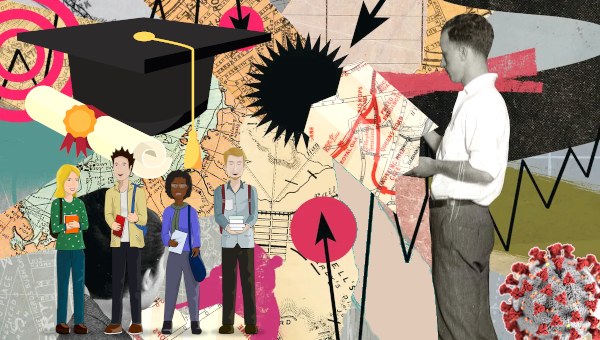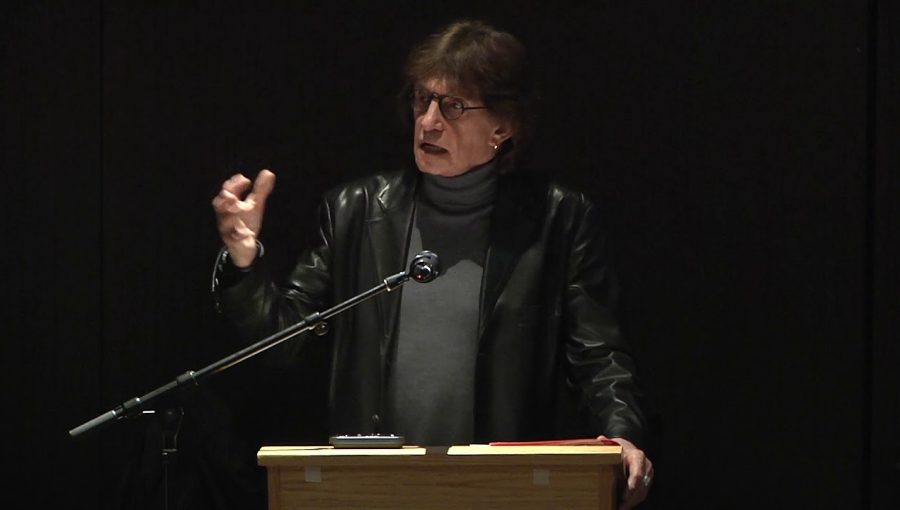A Falling Rate of Learning? Commodification and Neoliberal Education
Under neoliberal capitalism, the commodification of education has accelerated. Before the establishment of the current accumulation regime, the educational sector was predominantly controlled by an interventionist state, committed to countercyclical macroeconomic management. The labour process of teaching within a state-owned domain followed the general pattern of any other production process. According to Michael Heinrich, such a general form – which is independent of any social determinations – comprises a distinction “among functional activity (labour), the object of labour (which is modified by labour), and the means of labour (the tools with which this process of modification is made possible) as elements of the labour process.”
In the educational setting, labour is the teacher’s intellectual labour-power, the object of labour refers to students, and the means of labour comprises various teaching resources, equipment, etc. The state organizes these factors into a particular set of relationships of production. Through the interaction between the elements of the production process, knowledge is generated, which is ultimately crystallized in the new labour-power of educated and enculturated students. Thus, as Karl Marx stated, “Education produces labour capacity.” Through the production of knowledge-enhanced labour-power, the teachers contribute to an increase in labour productivity and facilitate the expansion of capital. In this pedagogical operation, teachers not only aid the reproduction of capital but also create surplus-value. David Harvie explains:
“[T]he exchange value of school, college or university graduates’ labour-power (i.e., the wage they can command) may reflect the cost of their education; that is, the value of their educators’ labour-power, rather than the value produced by their educators and embodied in the graduates. Yet graduates are, at least potentially, more productive by virtue of their education: by employing these graduates, capital is thereby able to appropriate not only the surplus value produced by them, but also that produced by their teachers.”

Skilling the Future Labour Force
As is evident, public education meets certain demands of capitalist development. By skilling and socializing the future labour force, mass homogenous education enables the extensive mobility of personnel that is required under capitalism, in contrast to the feudal era, when people rarely went out of their villages or local areas. In this way, a person is equipped to serve the needs of capital, no matter where s/he is. The mass of working people that is to be educated is dependent on the degree of development of the productive forces. Marx remarked:
“In order to modify the human organism, so that it may acquire skill and handiness in a given branch of industry, and become labour-power of a special kind, a special education or training is requisite, and this, on its part, costs an equivalent in commodities of a greater or less amount. This amount varies according to the more or less complicated character of the labour-power [emphasis mine]. The expenses of this education (excessively small in the case of ordinary labour-power), enter pro tanto into the total value spent in its production.”
In the post-World War II period, provisions for universal education were made by the state in both the Global North and Global South. For the Global North, the reasons for universalizing education were: a) the need for an educated workforce to promote dynamic economic growth, particularly in science, technology, and other white-collar job categories; and b) the threat of communism – represented by the Soviet Union – which forced the Western ruling classes to create a class collaborationist social contract aimed at the fulfillment of workers’ basic needs. For the Global South, the reasons for universalizing education were: a) the need to produce urban pockets of semi-skilled and high-skilled labourers for the smooth execution of import-substitution industrialization; and b) the political dynamics of post-colonial national compacts, which required Third World elites to alleviate mass poverty through welfarist methods.
The promise of universal, state-sponsored education began to wither from the late 1960s. This was caused by the recession that both Global North and South economies faced due to distinct reasons and which forced them to dismantle public education in order to open new opportunities for capitalist expansion. In the Euro-Atlantic world, the economic crisis was the result of a falling rate of profit. According to Edward N. Wolff, the rate of profit decreased by 5.4% from 1966 to 1979 – a downfall precipitated by an increase in the organic composition of capital, along with the contradictions of permanent arms economy and growing international competition. In the Global South, the economic crisis was caused by a drop in commodity prices, which made the states borrow heavily. To recover, they turned to the International Monetary Fund (IMF). In return for offering short-term credit, the IMF demanded “structural adjustments” – a euphemism for austerity and the destruction of public utilities.
Privatization and the End to Public Education
Disinvestment of state-sector equity and privatization of state-sector assets, invariably at throwaway prices, put an end to public education. This process symbolized the thorough commodification of education. In the words of Prabhat Patnaik, this means “not only that the labour-power of those who are the products of the education system becomes a commodity, but that the education itself that goes into the production of this commodity [knowledge] becomes a commodity. The education system becomes in other words a process for the production of a commodity (the labour-power of those who receive education) by means of a commodity (the education they receive).” In other words, education itself becomes a source of profit-making.
Marx had predicted this when he wrote the following in volume one of Capital: A Critique of Political Economy:
“That labourer alone is productive, who produces surplus-value for the capitalist, and thus works for the self-expansion of capital. If we may take an example from outside the sphere of production of material objects, a schoolmaster is a productive labourer, when, in addition to belabouring the heads of his scholars, he works like a horse to enrich the school proprietor. That the latter has laid out his capital in a teaching factory, instead of in a sausage factory, does not alter the relation.”
In “Theories of Surplus Value,” he similarly said:
“[T]he teachers in educational establishments may be mere wage workers for the entrepreneur of the establishment; many such educational factories exist in England. Although in relation to the pupils such teachers are not productive workers, they are productive workers in relation to their employer. He exchanges his capital for their labour-power, and through this process enriches himself.”
The privatization of education is not just another tactical decision taken by capital to overcome barriers to surplus-extraction. It represents a qualitatively developed version of capitalism, one in which capital directly produces socially reproductive processes. As Marx elaborated in the Grundrisse:
“The highest development of capital exists when the general conditions of the process of social reproduction are not paid for out of deductions from the social revenue, the state’s taxes – where revenue and not capital appears as the labour fund, and where the worker, although he is a free wage worker like any other, nevertheless stands economically in a different relation – but rather out of capital as capital. This shows the degree to which capital has subjugated all conditions of social reproduction to itself, on one side; and, on the other side, hence, the extent to which social reproductive wealth has become capitalized, and all needs are satisfied through the exchange form; as well as the extent to which the socially posited needs of the individual, i.e., those which he consumes and feels not as a single individual in society, but communally with others – whose mode of consumption is social by the nature of the thing – are likewise not only consumed but also produced through exchange, individual exchange.”
When private accumulation through an expropriation of state assets meets vigorous resistance, public-sector activities themselves are cheapened through exploitative methods. In the case of education, the state either lowers labour costs by devaluing the work of teaching or asks teachers to do more with the same or fewer resources. This predictably leads to systematic casualization and forced flexibilization. Budgetary cuts to government institutions lead to problems of underfunding, encouraging the university administration to seek the help of external funders, such as well-resourced corporations. In this way, universities get reconstructed as an educational equivalent of joint-stock companies, subject to the ruthless and coercive logic of competition for research grants and student numbers.
While in the initial period of neoliberalization the gutting of public education functioned as a conjunctural move to shore up profit rates, over the succeeding years it became structurally tethered to the economic requirements of a reworked productive base. In Northern countries, neoliberalism has led to three developments. First, investments have decreased due to overproduction, weak demand (caused by wage depression), and low profit rates in the productive sectors. Consequently, asset accumulation by speculative means has replaced actual accumulation or productive investment as a route to the increase of wealth, generating a system whose growth is based on financial bubbles and unsustainable explosions of credit/debt.
Second, given the already high organic composition of capital, new productive investments have relied on automation, thus giving a temporary market advantage to the capitalist who is the first to introduce the technology. This technology allows him/her to squeeze out more value from each worker in a given period of time. But when the labour-saving technology becomes generalized in a sector, the benefits accruing to the capitalist are eliminated, since everyone now produces commodities with the same automated labour process. Third, Northern capital has shifted the locus of value creation from the core to the periphery, outsourcing jobs to the Third World, where wages are very low. In other words, giant multinational monopolies are using differential rates of national exploitation to gain super-profits.
Deskilling Labour
All in all, the net effect of the aforementioned three changes is to reduce the number of individuals who are needed as trained workers in the Global North and thus, to progressively deskill work. This, in turn, eliminates the need for an architecture of public education. In his book The Falling Rate of Learning and the Neoliberal Endgame, David Blacker explains:
“The situation with production has changed due to its automation and globalization such that proportionately far fewer of the individuals once comprising the working classes of the global North are needed as workers. These people are being cut out of the economic loop altogether through a variety of proximal means: outsourcing, attrition, layoffs, etc. They are being ‘casualized’, which is to say rendered ever-more precarious as forced participants in an increasingly stressful, dangerous, less stable, and less remunerative subsistence ‘informal’ economy. The autoworker becomes a service attendant who becomes a street vendor or worse… How much education do these latter really need? How much will elites tax themselves for such ‘waste’?”
In Southern countries, neoliberalism has signified the assassination of the Third World project and the attendant blockage of autocentric development. This has translated into the entrenchment of extroverted economies. Countries rich in natural resources export primary goods to the Global North, and then tend to re-import manufactured products from these same countries. The value added to these manufactured commodities – typically constructed from the primary inputs imported earlier – generates profit for Northern countries while maintaining the Southern countries in a perpetual trade deficit. Other countries have soldered their economic engine to giant multinational corporations who, through outsourcing operations and subcontracting chains, extend parts of their productive processes to the South in search of abundant and cheap labour.
The twin processes of primarization and global labour arbitrage have converted the Third World into an impoverished arena of labour-intensive activities such as extractivism, production, processing, and assembly, with export-oriented industrialization never going beyond the production of simple parts in mass quantities. Performing relatively unspecialized operations for multinationals, the jobs of peripheral workers generally feature low wages, high labour intensity, long working hours, and poor working environments. The global tendency toward deskilling, however, has not completely erased skilled labour. Financialization and the revolution in communications and digitalized technology have given rise to elitist and exclusive high-tech education training for high-skilled and knowledge workers. William I. Robinson notes:
“[W]ork is increasingly polarized between unskilled and low-skilled labour on the farms and in the factories and office and service complexes of the global economy (as well as in the armed and security forces of the global police state), and on the other hand, high skilled technical and knowledge workers. While it is still too early to draw a final conclusion, it is likely that the revolutions just getting underway in nanotechnology, bio-engineering, 3D manufacturing, the Internet of Things, and robotic and machine intelligence – the revolutionary technologies of the immediate future, the so-called fourth industrial revolution – will only heighten this tendency toward bifurcation in the world’s workforce between high-skilled tech and knowledge workers and those relegated to Mcjobs, at best, or simply to surplus labour.”
Taking into account the inextricability of neoliberal capitalism and a deregulated-commodified education, any struggle for public education has to strike at the very roots of economic exploitation. If the grotesque wealth inequalities inflicted by neoliberal savagery upon the working masses are allowed to remain, then a proliferation of public institutions providing inexpensive education would result only in the subsidization of upwardly mobile social classes. Therefore, a growth in government spending on education has to be accompanied by a strategy of nationalizations, wealth taxation, capital controls, etc. Even then, the sustainable spread of socially progressive and universal education can be ensured only when the decision-making on investment and jobs has been taken out of the hands of the capitalist sector. For all of this to happen, we need to build a radical movement that is willing to abolish capitalism and pave the way toward communist experiments. •





